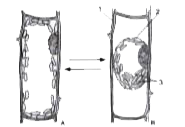A plant cell when kept in a certain solution got plasmolysed. What was the nature of the solution ?
To determine the nature of the solution in which a plant cell got plasmolysed, we can follow these steps:
1. Understanding Plasmolysis:
- Plasmolysis is the process where the protoplasm (the living part of the cell) shrinks away from the cell wall due to the loss of water.
2. Identifying the Conditions for Plasmolysis:
- Plasmolysis occurs when a plant cell is placed in a solution that has a higher concentration of solutes compared to the inside of the cell. This condition leads to water moving out of the cell.
3. Defining Hypertonic Solution:
- A solution that has a higher concentration of solutes (and thus a lower concentration of water) compared to the inside of the cell is called a hypertonic solution.
4. Water Movement:
- Water moves from an area of higher water potential (inside the cell) to an area of lower water potential (the hypertonic solution) until equilibrium is reached. This results in the protoplasm pulling away from the cell wall.
5. Conclusion:
- Therefore, the nature of the solution in which the plant cell got plasmolysed is hypertonic.
Final Answer:
The solution is hypertonic.
---
- Plasmolysis is the process where the protoplasm (the living part of the cell) shrinks away from the cell wall due to the loss of water.
- Plasmolysis occurs when a plant cell is placed in a solution that has a higher concentration of solutes compared to the inside of the cell. This condition leads to water moving out of the cell.
- A solution that has a higher concentration of solutes (and thus a lower concentration of water) compared to the inside of the cell is called a hypertonic solution.
- Water moves from an area of higher water potential (inside the cell) to an area of lower water potential (the hypertonic solution) until equilibrium is reached. This results in the protoplasm pulling away from the cell wall.
- Therefore, the nature of the solution in which the plant cell got plasmolysed is hypertonic.
The solution is hypertonic.
Topper's Solved these Questions
- BOOK - ICSECHAPTER - TRANSPORT IN PLANTS EXERCISE - TEST YOUR PROGRESS (SHORT/LONG ANSWER TYPE QUESTIONS)34videos
TRANSPORT IN PLANTS
- BOOK - ICSECHAPTER - TRANSPORT IN PLANTS EXERCISE - TEST YOUR PROGRESS (HIGHER ORDER THINKING SKILLS QUESTIONS (HOTS))9videos
TRANSPORT IN PLANTS
- BOOK - ICSECHAPTER - TRANSPORT IN PLANTS EXERCISE - TEST YOUR PROGRESS (State whether the following statements are true or false)16videos
TRANSPORT IN PLANTS
- BOOK - ICSECHAPTER - THE LIVING WORLD EXERCISE - Ncert Exercises (Differentiate Between )4videos
THE LIVING WORLD
Similar Questions
Knowledge Check
- Question 1 - Select One
A plant cell shrinks when it is kept in
Ahypotonic solutionBhypertonic solutionCisotonic solutionDpure water
What is the nature of an aqueous solution of CO2?
View SolutionA cell placed in a solution get deplasmolysed . The solution is
View SolutionA plant cell is kept in a hypotonic solution. What will happen to the solute potential of this cell?
View SolutionWhat is the nature of an aqueous solution of borax ?
View SolutionPlant cell kept in saline drop will
View SolutionWhen a cell is plasmolysed
View SolutionIn the given figures 'A' shows a cell in the normal state and 'B' shows the same cell after leaving it in a certain solution for a few minutes :

Was the solution isotonic, hypotonic or hypertonic in which the cell was kept ?View Solution

